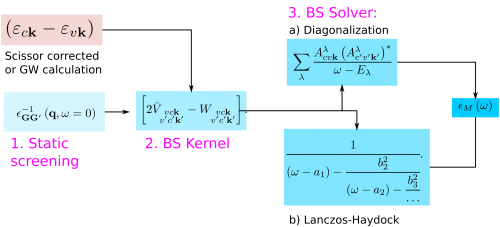Difference between revisions of "Calculating optical spectra including excitonic effects: a step-by-step guide"
| Line 14: | Line 14: | ||
[[File:Scheme1.png|500px|center|BSE calculation scheme]] | [[File:Scheme1.png|500px|center|BSE calculation scheme]] | ||
The optical absorption spectrum corresponds to Imε<sub>M</sub>(ω). | The optical absorption spectrum corresponds to Imε<sub>M</sub>(ω). Following this scheme we go through the flow of a calculation: | ||
===Step 1: Static screening=== | |||
Use the ''SAVE'' folders that are already provided. For the CECAM tutorial, do: | |||
$ cd YAMBO_TUTORIALS/hBN/YAMBO | |||
Follow the '''[[Static screening]]''' module and then '''return to this tutorial '''Calculating optical spectra...''' | |||
===Step 2: Bethe-Salpeter kernel=== | ===Step 2: Bethe-Salpeter kernel=== | ||
Follow the module on '''[[Bethe-Salpeter kernel]]''' and '''return to this tutorial "Calculating optical spectra..." ''' | |||
===Step 3: Bethe-Salpeter solver=== | ===Step 3: Bethe-Salpeter solver=== | ||
This is the final step in which you finally obtained the spectra. | |||
Mathematically this implies to solve a large eigenvalue problems. | |||
Two main solvers are available in yambo | |||
(1) diagonalization of the full Hamiltonian (diagonalization solver) | |||
(2) subspace iterative [https://en.wikipedia.org/wiki/Lanczos_algorithm| Lanczos algorithm] which by-pass diagonalization with the Haydock approach<ref>R. Haydock, in | |||
''Solid State Phys.'', '''35''' 215 (1980) edited by H. Ehrenfest, F. Seitz, and D. Turnbull, Academic Press</ref> (Lanczos-Haydock solver) | |||
For (1) follow the module on '''[[Bethe-Salpeter solver: diagonalization]]''' then either '''return to this tutorial "Calculating optical spectra..." ''' | |||
or follow the link to '''[[Bethe-Salpeter solver: Lanczos-Haydock]]''' for (2). | |||
<!-- | <!-- | ||
Revision as of 14:26, 17 April 2017
WORK IN PROGRESS - by Myrta Grüning
This tutorial guides you through the workflow of a calculation of the optical spectrum of a given material by solving the Bethe-Salpeter equation. Specifically we will use bulk h-BN as an example.
Before starting, you need to obtain the tarballs for hBN. See instructions on the main tutorials page.
The target quantity in a Bethe-Salpeter calculation is the macroscopic dielectric matrix εM. The following quantities/steps are needed to obtain εM:
The optical absorption spectrum corresponds to ImεM(ω). Following this scheme we go through the flow of a calculation:
Step 1: Static screening
Use the SAVE folders that are already provided. For the CECAM tutorial, do:
$ cd YAMBO_TUTORIALS/hBN/YAMBO
Follow the Static screening module and then return to this tutorial Calculating optical spectra...
Step 2: Bethe-Salpeter kernel
Follow the module on Bethe-Salpeter kernel and return to this tutorial "Calculating optical spectra..."
Step 3: Bethe-Salpeter solver
This is the final step in which you finally obtained the spectra. Mathematically this implies to solve a large eigenvalue problems. Two main solvers are available in yambo
(1) diagonalization of the full Hamiltonian (diagonalization solver)
(2) subspace iterative Lanczos algorithm which by-pass diagonalization with the Haydock approach[1] (Lanczos-Haydock solver)
For (1) follow the module on Bethe-Salpeter solver: diagonalization then either return to this tutorial "Calculating optical spectra..." or follow the link to Bethe-Salpeter solver: Lanczos-Haydock for (2).
References
- ↑ R. Haydock, in Solid State Phys., 35 215 (1980) edited by H. Ehrenfest, F. Seitz, and D. Turnbull, Academic Press

